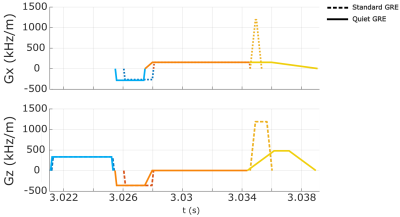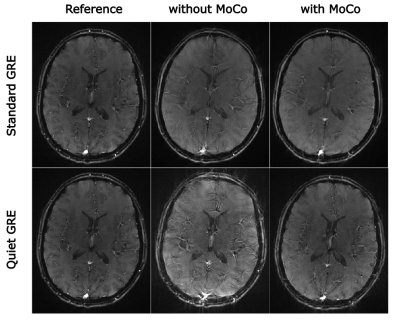1709
Rapid prototyping of a motion-robust 2D Radial GRE sequence with reduced acoustic noise generation using Pulseq
Elisa Marchetto1,2, Maxim Zaitsev3, and Daniel Gallichan1,2
1School of Engineering, Cardiff University, Cardiff, United Kingdom, 2Cardiff University Brain Research Centre (CUBRIC), Cardiff University, Cardiff, United Kingdom, 3High Field MR Center, Center for Medical Physics and Biomedical Engineering, Medical University of Vienna, Vienna, Austria
1School of Engineering, Cardiff University, Cardiff, United Kingdom, 2Cardiff University Brain Research Centre (CUBRIC), Cardiff University, Cardiff, United Kingdom, 3High Field MR Center, Center for Medical Physics and Biomedical Engineering, Medical University of Vienna, Vienna, Austria
Synopsis
A radial GRE-sequence was modified using Pulseq to reduce the acoustic noise amount produced by the rapid switching of gradient currents without excessively increasing the TR-time. Prospective motion-correction was performed using a markerless tracking device that sent the motion estimates to the scanner via the libXPACE framework, incorporated directly into Pulseq, to update gradients and RF pulses during the MR scan. The quieter sequence resulted in a acoustic noise reduction of 6 dB(A) (i.e. a factor of 2) compared to the standard one. Image quality was greatly improved using prospective motion-correction in the case of deliberate motion during the scan.
Introduction
Rapid changes of gradient currents are the source of magnetic resonance (MR) acoustic noise, because of the Lorentz forces acting on the gradient coils1. Quiet sequences can be adopted to reduce the scanning noise by increasing TE and TR2 or by using soft gradient waveforms3 to reduce abrupt changes of the gradient level. In this preliminary study, we adjusted the gradient timings and shape of a radial Gradient Echo (GRE)4 sequence using Pulseq5. Prospective motion correction of voluntary motion was carried out using a markerless device tracking communicating with the scanner via the libXPACE (eXternal Prospective Acquisition CorrEction)6 framework, that was linked directly to a customized Pulseq interpreter. The aim moving forward is to obtain motion-robust methods to acquire images with a low acoustic noise level, making them suitable for a paediatric/infant age group where research scans are typically conducted while the subject is sleeping.Methods
Pulseq is an open-source framework for the development and execution of magnetic resonance (MR) pulse sequences. We used the latest Matlab-based version (1.4.0) to reduce the acoustic noise generated by a standard 2D radial GRE sequence by allowing the gradients to ramp-up slower, without increasing the TR excessively. Spoiler gradients were performed by extending the ramp-down gradient area, while the slice-selection gradient was ramped more slowly minimising abrupt changes in gradient amplitude. Care was also taken to align temporally all ramps that would not affect the image encoding. Standard and acoustically optimized sequences were tested on a Prisma scanner (Siemens Healthcare, Erlangen, Germany) with TR/TE at 18.2/8 ms, FA=20°, slice thickness=3mm and FOV=256mm. Preliminary scans were performed with a phantom to perform acoustic-noise measurements using Decibel X app (SkyPaw Co., Ltd) from a mobile phone device positioned at the entrance of the scanner room. The sequences were tested in vivo with the participant performing slow back-and-forth head rotation with and without motion correction enabled. The real-time motion-tracking estimates were sent to the scanner and coordinate systems updated using the libXPACE framework, to allow prospective motion correction using a Tracoline (TCL) markerless device (TracInnovations, Ballerup, Denmark). A separate image was also collected without deliberate motion as reference. Image reconstruction was performed in MATLAB using the Pulseq reconstruction script for non-Cartesian sampling.Results
A comparison between the standard and the quieter pulse sequence is shown in Figure 1: spoiler gradient amplitudes were considerably reduced as well as time-gaps between gradients, optimized to allow slower gradient rising and falling. The quiet and standard sequences resulted in a LMax value of 62.2 db(A) and 68.5 db(A) respectively, with the acoustic noise measurements shown in Figure 2 for comparison. Figure 3 compares images acquired with and without motion correction against the reference images for both sequences: reasonable image contrast was obtained, and the prospective motion correction worked well, reducing the motion artifacts occurring during the single slice acquisition. The motion parameters measured by the tracking device during the experiments with and without motion correction are shown in Figure 4.Discussion
Slower rising and falling of gradients as well as optimization of spoiler gradient areas resulted in 6 db(A) reduction of acoustic noise compared to the standard radial GRE sequence. The acoustic noise measurement was performed at the entrance of the scanner room for safety reasons. Future study will require the use of a calibrated MR safe equipment at the entrance of the scanner bore where the strongest noise can be measured1. Moreover, further acoustic noise reduction could be achieved by substituting the traditional trapezoid shape with ‘soft’ gradients, such as sinusoids or gaussians, which can be trivially achieved with Pulseq. The motion parameters tracked by the TCL device show that the motion performed by the subject has comparable magnitude, although differing in the shape depending at what moment of the back-and-forth head motion the scan took place. For this proof-of-concept study, the motion correction was tested successfully for one single slice acquisition. Further study will investigate the motion correction robustness in the case of multi-slice acquisitions. Even in the images where no motion correction was applied, some fine anatomical features can still be recognized. This is attributed to the inherent robustness of radial sampling to motion, where motion artifacts tend to be less severe than for Cartesian sampling. Nonetheless, prospectively corrected images show substantially higher image sharpness and the level of detail.Conclusion
In this study, we successfully reduced the acoustic noise of a standard 2D radial GRE sequence using Pulseq, maintaining a relatively short TR time. Good image quality could be achieved using prospective motion correction from the TCL markerless tracking device, integrated with the scanner through the libXPACE framework. Further studies will investigate the robustness of sequence and motion correction methods in the case of multi-slice acquisition in infant subjects, taking advantage of the acoustic noise reduction especially when no sedation or anaesthesia are used.Acknowledgements
This work is partly funded by research support from TracInnovations (Ballerup, Denmark).References
- Price D, De Wilde J, Papadaki A, et al. Investigation of Acoustic Noise on 15 MRI Scanners from 0.2 T to 3 T. Journal Of Magnetic Resonance Imaging 2001; 13:288–293.
- Arthurs 0, Edwards A, Austin T. The challenges of neonatal magnetic resonance imaging. Pediatr Radiol 2012; 42:1183–1194.
- Hennel F, Giard F, Loenneker T. Silent MRI with soft gradient pulses. Mag Res Med 1999;42:6-10.
- Elster AD. Gradient echo imaging: techniques and acronyms. Radiology 1993; 186:1-8.
- http://pulseq.github.io/
- Zaitsev M, Woletz M, Tik M. Real-time prospective motion correction of arbitrary MR pulse sequences with XPACE-Pulseq. ISMRM 2021, Abstract #1378.
Figures

Figure 1. Comparison between the original standard sequence
(dashed line) and the quiet version (solid line). Spoiler gradient amplitude is
dramatically reduced in the quiet version compared to the standard one by
extending the ramp-down area of the readout gradient yet keeping the TR time
relatively short (TR=18.2 ms).

Figure 2. Acoustic Noise measurements collected using
Decibel X app through a mobile phone positioned outside the scanner room for the
standard GRE sequence (A) and the quiet version (B). The red vertical lines
bound the beginning and end of the two sequences (red line), while the blue
line represents the scanner room noise when no sequence is run.

Figure 3. Comparison between prospective motion corrected
images (with MoCo) and without motion correction (without MoCo) acquired using
the standard and the quiet GRE sequences. Motion-free scan without motion correction is reported here as Reference.

Figure 4. Motion parameters obtained by the TCL tracking device
without and with motion correction (without MoCo and with MoCo respectively)
for the standard and quiet GRE sequences.
DOI: https://doi.org/10.58530/2022/1709